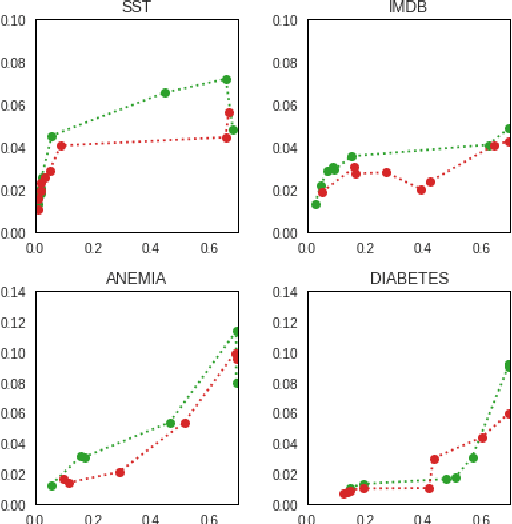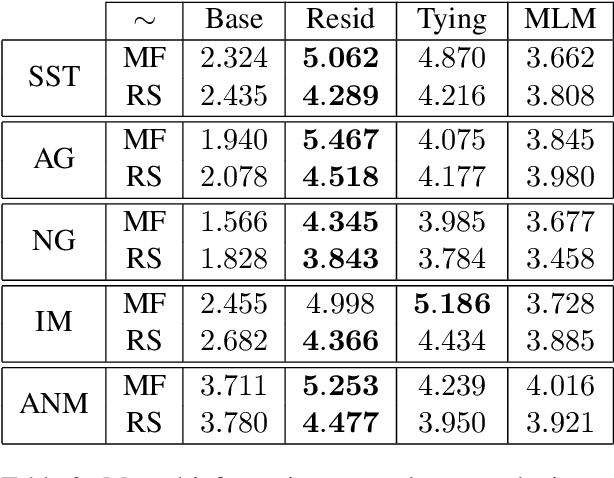Martin Tutek
Characterizing Linguistic Shifts in Croatian News via Diachronic Word Embeddings
Jun 16, 2025Abstract:Measuring how semantics of words change over time improves our understanding of how cultures and perspectives change. Diachronic word embeddings help us quantify this shift, although previous studies leveraged substantial temporally annotated corpora. In this work, we use a corpus of 9.5 million Croatian news articles spanning the past 25 years and quantify semantic change using skip-gram word embeddings trained on five-year periods. Our analysis finds that word embeddings capture linguistic shifts of terms pertaining to major topics in this timespan (COVID-19, Croatia joining the European Union, technological advancements). We also find evidence that embeddings from post-2020 encode increased positivity in sentiment analysis tasks, contrasting studies reporting a decline in mental health over the same period.
MIB: A Mechanistic Interpretability Benchmark
Apr 17, 2025Abstract:How can we know whether new mechanistic interpretability methods achieve real improvements? In pursuit of meaningful and lasting evaluation standards, we propose MIB, a benchmark with two tracks spanning four tasks and five models. MIB favors methods that precisely and concisely recover relevant causal pathways or specific causal variables in neural language models. The circuit localization track compares methods that locate the model components - and connections between them - most important for performing a task (e.g., attribution patching or information flow routes). The causal variable localization track compares methods that featurize a hidden vector, e.g., sparse autoencoders (SAEs) or distributed alignment search (DAS), and locate model features for a causal variable relevant to the task. Using MIB, we find that attribution and mask optimization methods perform best on circuit localization. For causal variable localization, we find that the supervised DAS method performs best, while SAE features are not better than neurons, i.e., standard dimensions of hidden vectors. These findings illustrate that MIB enables meaningful comparisons of methods, and increases our confidence that there has been real progress in the field.
Measuring Faithfulness of Chains of Thought by Unlearning Reasoning Steps
Feb 20, 2025Abstract:When prompted to think step-by-step, language models (LMs) produce a chain of thought (CoT), a sequence of reasoning steps that the model supposedly used to produce its prediction. However, despite much work on CoT prompting, it is unclear if CoT reasoning is faithful to the models' parameteric beliefs. We introduce a framework for measuring parametric faithfulness of generated reasoning, and propose Faithfulness by Unlearning Reasoning steps (FUR), an instance of this framework. FUR erases information contained in reasoning steps from model parameters. We perform experiments unlearning CoTs of four LMs prompted on four multi-choice question answering (MCQA) datasets. Our experiments show that FUR is frequently able to change the underlying models' prediction by unlearning key steps, indicating when a CoT is parametrically faithful. Further analysis shows that CoTs generated by models post-unlearning support different answers, hinting at a deeper effect of unlearning. Importantly, CoT steps identified as important by FUR do not align well with human notions of plausbility, emphasizing the need for specialized alignment
REVS: Unlearning Sensitive Information in Language Models via Rank Editing in the Vocabulary Space
Jun 13, 2024Abstract:Large language models (LLMs) risk inadvertently memorizing and divulging sensitive or personally identifiable information (PII) seen in training data, causing privacy concerns. Current approaches to address this issue involve costly dataset scrubbing, or model filtering through unlearning and model editing, which can be bypassed through extraction attacks. We propose REVS, a novel model editing method for unlearning sensitive information from LLMs. REVS identifies and modifies a small subset of neurons relevant for each piece of sensitive information. By projecting these neurons to the vocabulary space (unembedding), we pinpoint the components driving its generation. We then compute a model edit based on the pseudo-inverse of the unembedding matrix, and apply it to de-promote generation of the targeted sensitive data. To adequately evaluate our method on truly sensitive information, we curate two datasets: an email dataset inherently memorized by GPT-J, and a synthetic social security number dataset that we tune the model to memorize. Compared to other state-of-the-art model editing methods, REVS demonstrates superior performance in both eliminating sensitive information and robustness to extraction attacks, while retaining integrity of the underlying model. The code and a demo notebook are available at https://technion-cs-nlp.github.io/REVS.
Code Prompting Elicits Conditional Reasoning Abilities in Text+Code LLMs
Jan 18, 2024Abstract:Reasoning is a fundamental component for achieving language understanding. Among the multiple types of reasoning, conditional reasoning, the ability to draw different conclusions depending on some condition, has been understudied in large language models (LLMs). Recent prompting methods, such as chain of thought, have significantly improved LLMs on reasoning tasks. Nevertheless, there is still little understanding of what triggers reasoning abilities in LLMs. We hypothesize that code prompts can trigger conditional reasoning in LLMs trained on text and code. We propose a chain of prompts that transforms a natural language problem into code and prompts the LLM with the generated code. Our experiments find that code prompts exhibit a performance boost between 2.6 and 7.7 points on GPT 3.5 across multiple datasets requiring conditional reasoning. We then conduct experiments to discover how code prompts elicit conditional reasoning abilities and through which features. We observe that prompts need to contain natural language text accompanied by high-quality code that closely represents the semantics of the instance text. Furthermore, we show that code prompts are more efficient, requiring fewer demonstrations, and that they trigger superior state tracking of variables or key entities.
Out-of-Distribution Detection by Leveraging Between-Layer Transformation Smoothness
Oct 04, 2023Abstract:Effective OOD detection is crucial for reliable machine learning models, yet most current methods are limited in practical use due to requirements like access to training data or intervention in training. We present a novel method for detecting OOD data in deep neural networks based on transformation smoothness between intermediate layers of a network (BLOOD), which is applicable to pre-trained models without access to training data. BLOOD utilizes the tendency of between-layer representation transformations of in-distribution (ID) data to be smoother than the corresponding transformations of OOD data, a property that we also demonstrate empirically for Transformer networks. We evaluate BLOOD on several text classification tasks with Transformer networks and demonstrate that it outperforms methods with comparable resource requirements. Our analysis also suggests that when learning simpler tasks, OOD data transformations maintain their original sharpness, whereas sharpness increases with more complex tasks.
CATfOOD: Counterfactual Augmented Training for Improving Out-of-Domain Performance and Calibration
Sep 15, 2023Abstract:In recent years, large language models (LLMs) have shown remarkable capabilities at scale, particularly at generating text conditioned on a prompt. In our work, we investigate the use of LLMs to augment training data of small language models~(SLMs) with automatically generated counterfactual~(CF) instances -- i.e. minimally altered inputs -- in order to improve out-of-domain~(OOD) performance of SLMs in the extractive question answering~(QA) setup. We show that, across various LLM generators, such data augmentation consistently enhances OOD performance and improves model calibration for both confidence-based and rationale-augmented calibrator models. Furthermore, these performance improvements correlate with higher diversity of CF instances in terms of their surface form and semantic content. Finally, we show that CF augmented models which are easier to calibrate also exhibit much lower entropy when assigning importance, indicating that rationale-augmented calibrators prefer concise explanations.
Easy to Decide, Hard to Agree: Reducing Disagreements Between Saliency Methods
Nov 15, 2022Abstract:A popular approach to unveiling the black box of neural NLP models is to leverage saliency methods, which assign scalar importance scores to each input component. A common practice for evaluating whether an interpretability method is \textit{faithful} and \textit{plausible} has been to use evaluation-by-agreement -- multiple methods agreeing on an explanation increases its credibility. However, recent work has found that even saliency methods have weak rank correlations and advocated for the use of alternative diagnostic methods. In our work, we demonstrate that rank correlation is not a good fit for evaluating agreement and argue that Pearson-$r$ is a better suited alternative. We show that regularization techniques that increase faithfulness of attention explanations also increase agreement between saliency methods. Through connecting our findings to instance categories based on training dynamics we show that, surprisingly, easy-to-learn instances exhibit low agreement in saliency method explanations.
Staying True to Your Word: Can Attention Become Explanation?
May 19, 2020



Abstract:The attention mechanism has quickly become ubiquitous in NLP. In addition to improving performance of models, attention has been widely used as a glimpse into the inner workings of NLP models. The latter aspect has in the recent years become a common topic of discussion, most notably in work of Jain and Wallace, 2019; Wiegreffe and Pinter, 2019. With the shortcomings of using attention weights as a tool of transparency revealed, the attention mechanism has been stuck in a limbo without concrete proof when and whether it can be used as an explanation. In this paper, we provide an explanation as to why attention has seen rightful critique when used with recurrent networks in sequence classification tasks. We propose a remedy to these issues in the form of a word level objective and our findings give credibility for attention to provide faithful interpretations of recurrent models.
Iterative Recursive Attention Model for Interpretable Sequence Classification
Aug 30, 2018



Abstract:Natural language processing has greatly benefited from the introduction of the attention mechanism. However, standard attention models are of limited interpretability for tasks that involve a series of inference steps. We describe an iterative recursive attention model, which constructs incremental representations of input data through reusing results of previously computed queries. We train our model on sentiment classification datasets and demonstrate its capacity to identify and combine different aspects of the input in an easily interpretable manner, while obtaining performance close to the state of the art.
 Add to Chrome
Add to Chrome Add to Firefox
Add to Firefox Add to Edge
Add to Edge